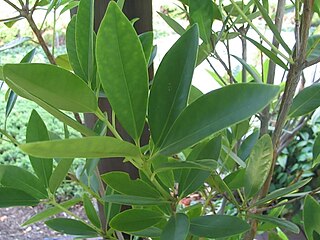
Illicium verum is a medium-sized evergreen tree native to northeast Vietnam and South China. It is a spice that closely resembles anise in flavor and is obtained from the star-shaped pericarps of the fruit of I. verum which are harvested just before ripening. Star anise oil is a highly fragrant oil used in cooking, perfumery, soaps, toothpastes, mouthwashes, and skin creams. Until 2012, when they switched to using a bacterial source, Roche Pharmaceuticals used up to 90% of the world's annual star anise crop to produce shikimic acid, a chemical intermediate used in the synthesis of oseltamivir (Tamiflu).
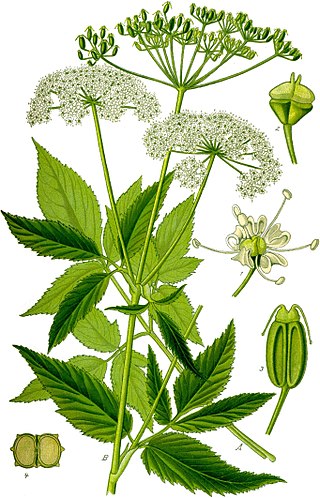
Aegopodium podagraria, commonly called ground elder, is a species of flowering plant in the carrot family Apiaceae that grows in shady places. The name "ground elder" comes from the superficial similarity of its leaves and flowers to those of elder (Sambucus), which is not closely related. Other common names include herb gerard, bishop's weed, goutweed, gout wort, snow-in-the-mountain, English masterwort and wild masterwort. It is the type species of the genus Aegopodium. It is native to Europe and Asia, but has been introduced around the world as an ornamental plant, where it occasionally poses an ecological threat as an invasive exotic plant.
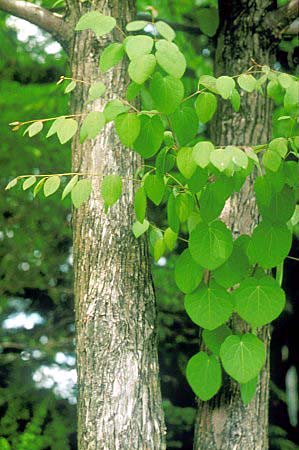
Cercidiphyllum is a genus containing two species of plants, both commonly called katsura. They are the sole members of the monotypic family Cercidiphyllaceae. The genus is native to Japan and China and unrelated to Cercis (redbuds).

Magnolia wilsonii, or Wilson's magnolia, is a species of Magnolia native to China, in the provinces of western Guizhou, Sichuan and northern Yunnan, where it grows in the forest understory at altitudes of 1,900-3,000 m, rarely up to 3,300 m.

The blue spruce, also commonly known as green spruce, Colorado spruce, or Colorado blue spruce, is a species of spruce tree native to North America in Arizona, Colorado, Idaho, New Mexico, Utah and Wyoming. It is noted for its blue-green colored needles, and has therefore been used as an ornamental tree in many places far beyond its native range.
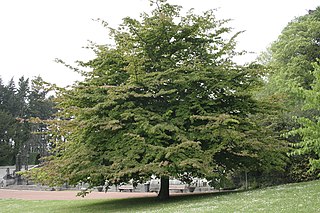
Parrotia persica, the Persian ironwood, is a deciduous tree in the family Hamamelidaceae, closely related to the witch-hazel genus Hamamelis. It is native to Iran's Caspian region and Azerbaijan. It is endemic in the Alborz mountains, where it is found mainly in Golestan National Park.

Grevillea robusta, commonly known as the southern silky oak, silk oak or silky oak, silver oak or Australian silver oak, is a flowering plant in the family Proteaceae, and accordingly unrelated to true oaks, family Fagaceae. Grevillea robusta is a tree, and is the largest species in its genus. It is a native of eastern coastal Australia, growing in riverine, subtropical and dry rainforest environments.

Illicium is a genus of flowering plants treated as part of the family Schisandraceae, or alternately as the sole genus of the Illiciaceae. It has a disjunct distribution, with most species native to eastern Asia and several in parts of North America, including the southeastern United States, Mexico, and the Caribbean. General common names include star anise and anisetree. The genus name comes from the Latin illicere.

Tecoma stans is a species of flowering perennial shrub in the trumpet vine family, Bignoniaceae, that is native to the Americas. Common names include yellow trumpetbush, yellow bells, yellow elder, ginger Thomas. Tecoma stans is the official flower of the United States Virgin Islands and the floral emblem of The Bahamas.

Iris pallida, the Dalmatian iris or sweet iris, is a hardy flowering perennial plant of the genus Iris, family Iridaceae. It is native to the Dalmatian coast (Croatia) but widely naturalised elsewhere. It is a member of the subgenus Iris, meaning that it is a bearded iris, and grows from a rhizome. It adapts well to different environments and is used in many different ways.
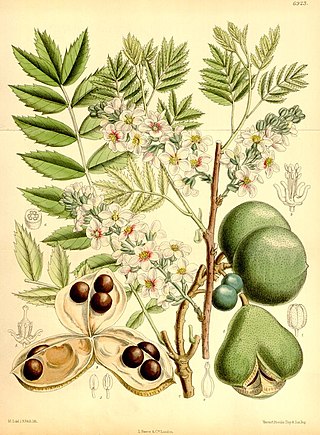
Xanthoceras sorbifolium, the yellowhorn, shiny leaf yellowhorn, goldenhorn, or Chinese flowering chestnut, is a woody oil tree species in the family Sapindaceae, and the only species in the genus Xanthoceras. It is native to northern China in the provinces of Gansu, Hebei, Henan, Liaoning, Nei Monggol, Ningxia, Shaanxi, and Shandong. It is also cultivated in Russia, having been imported there since the 19th Century. The genus name Xanthoceras is considered to be the most basal member of the family Sapindaceae. The specific epithet sorbifolium refers to the leaves, which resemble those of the distantly related rowans (Sorbus). It was originally spelled sorbifolia, but this is a grammatical error that was corrected to sorbifolium under the ICBN. X. sorbifolium is an ancient tree species. It is said it can live up to 2,000 years. It is a sacred tree planted in temples in northern China, because there is no Ficus religiosa in the north. It is also used in traditional Chinese, Mongolian and Tibetan medicine. In Bencao Gangmu, it is called '天仙果Heavenly Fairy Fruit'. Tenacious X. sorbifolium can grow in snow and drought like in Gobi Desert. Each organ of X. sorbifolium can provide multiple uses. It has very high alimentaire value, medicinal value, ornamental value and ecological value. In cultivation in the UK, X. sorbifolium has gained the Royal Horticultural Society's Award of Garden Merit.

Coelogyne flaccida is a species of orchid that is native to southeast Asia and northeastern South Asia. Cultivated as an ornamental plant, it is also known as the bearded coelogyne and the loose coelogyne.
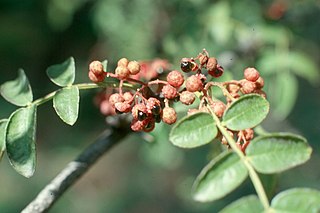
Zanthoxylum americanum, the common prickly-ash, common pricklyash, common prickly ash or northern prickly-ash, is an aromatic shrub or small tree native to central and eastern portions of the United States and Canada. It is the northernmost New World species in the citrus family, Rutaceae, and is the type species in its genus, which includes sichuan pepper. It can grow to 10 meters (33 ft) tall with a diameter at breast height (DBH) of 15 cm (5.9 in). It produces membranous leaflets and axillary flower clusters. The wood is not commercially valuable, but oil extracts from the bark have been used in traditional and alternative medicine, and have been studied for antifungal and cytotoxic properties. The genus name is sometimes spelled Xanthoxylum.

Paeonia ludlowii, is a deciduous shrub of medium height, belonging to the tree peony section Moutan of the genus Paeonia, and endemic to southeast Tibet. In Tibet it is known as ≠'lumaidao' meaning "God's flower". The vernacular name in Chinese is 大花黄牡丹 meaning "big yellow-flowered peony". In English it is sometimes called Tibetan tree peony or Ludlow's tree peony. It has pure yellow, slightly nodding, bowl-shaped flowers, and large, twice compounded, light green leaves.

Angelica acutiloba is a perennial herb from the family Apiaceae or Umbelliferous. It is predominately in Japan and perhaps endemic (unique). It is now distributed widely and cultivated in Jilin, China, Korea, Taiwan and Indonesia.

Paris polyphylla is an Asian species of flowering plant native to China, the Indian Subcontinent, and Indochina. It produces spider-like flowers that throw out long, thread-like, yellowish green petals throughout most of the warm summer months and into the autumn. In the fall, the flowers are followed by small, scarlet berries. It is a perennial, which slowly spreads, is fully hardy in Britain, and survives in leafy, moist soil in either complete or partial shade.

Meconopsis horridula, the prickly blue poppy, is a flowering plant from the family Papaveraceae. It is an endangered species that grows in high altitudes. The height of the plant varies from 20 cm to 1m. It is a monocarpic, dicot plant.

Magnolia biondii, or Biondi's magnolia, is a deciduous tree that flowers in late winter to early spring before leaf growth. Its early flowering nature gives it the name of the Hope for Spring Flower.
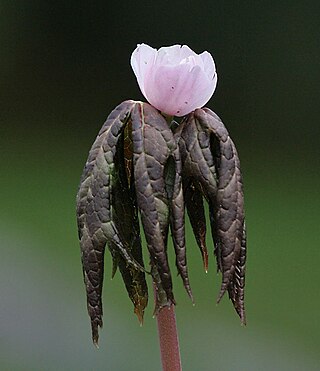
Sinopodophyllum is an herbaceous perennial plant in the family Berberidaceae, described as a genus in 1979. It includes only one known species, Sinopodophyllum hexandrum, native to Afghanistan, Bhutan, northern India, Kashmir, Nepal, Pakistan, and western China. Common names include Himalayan may apple and Indian may apple.
Illicium guajaibonense is a shrub endemic to Pinar del Rio in Western Cuba. It has only recently been recognized as a distinct species; previously it was considered to be subspecies of I. cubense. I. guajaibonense differs from I. cubense in flower color and other characters.





















